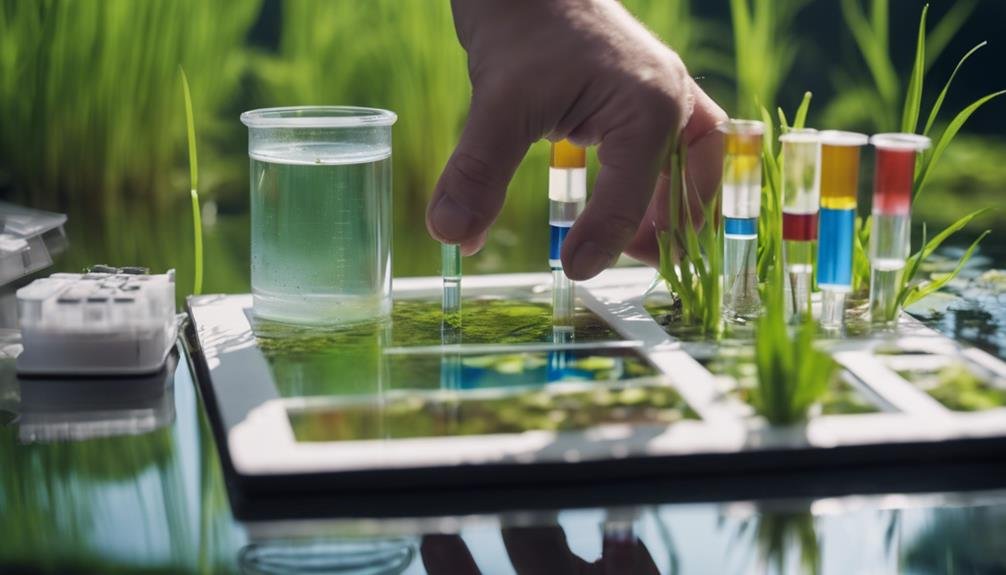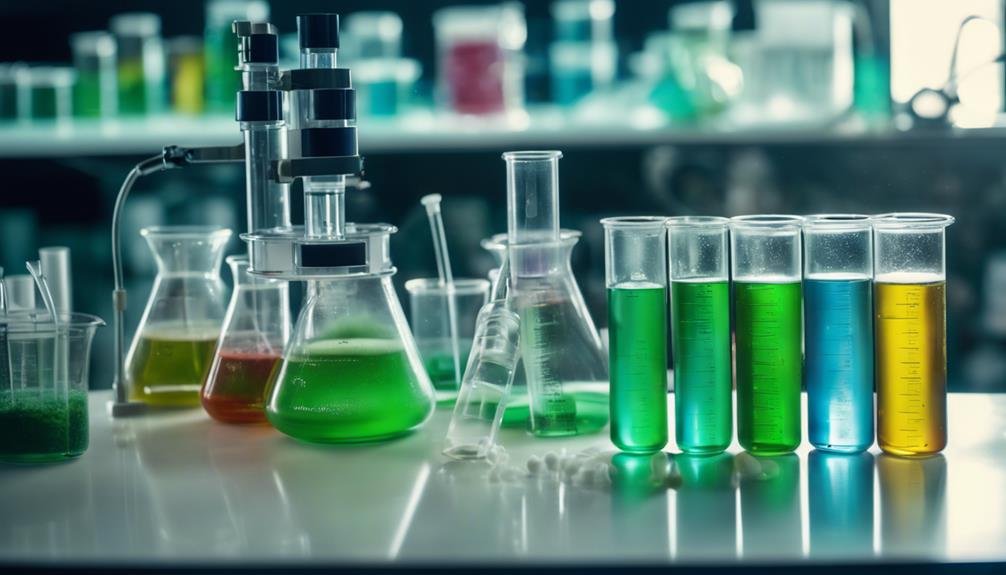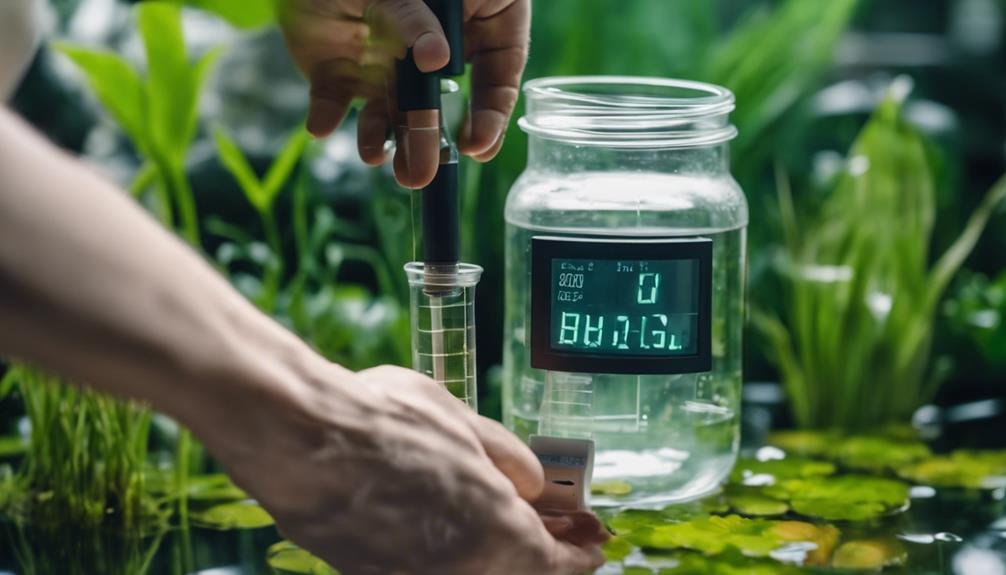To start testing your pond water, you'll need a complete test kit that measures pH, ammonia, nitrite, nitrate, and KH levels. Collect water samples from various depths and follow the kit's instructions carefully. Test regularly, especially during warmer months, and record your results. Ideal ranges include pH 6.5-8.5, ammonia close to 0 ppm, nitrite below 0.25 ppm, and nitrate under 50 ppm. If levels are off, consider partial water changes, chemical treatments, or improving filtration. Consistent monitoring helps prevent issues like algae blooms and fish stress. Understanding these basics will set you on the path to maintaining a healthy pond ecosystem.
Some of the links in this article may be affiliate links. If you make a purchase through these links, we may earn a small commission at no extra cost to you. Thank you.
Understanding Pond Water Quality
You'll need to grasp several key factors to fully understand pond water quality and maintain a healthy aquatic ecosystem.
One important element is the nitrogen cycle, which converts harmful ammonia into less toxic substances through beneficial bacteria. This process is essential for fish health and overall water quality.
Testing your pond's pH is another essential aspect. pH indicates the water's acidity or alkalinity, directly impacting the well-being of aquatic life. Regular monitoring helps you maintain ideal conditions for your pond inhabitants.
Oxygen levels are equally significant. Adequate dissolved oxygen, often introduced through aeration, is crucial for fish and other aquatic organisms to thrive. Testing oxygen levels regularly ensures your pond's ecosystem remains balanced.
Water hardness and phosphate levels also play significant roles in pond health. Hardness affects both plants and animals, while excessive phosphates can lead to algae blooms and other issues.
Essential Testing Parameters
To maintain a healthy pond ecosystem, it's important that you regularly test for five essential parameters: pH, ammonia, nitrite, nitrate, and KH levels. These water quality tests provide significant information about your pond's health and the well-being of your aquatic life.
pH levels indicate whether your pond water is acidic or alkaline. This measure affects various biological processes and the overall health of your pond fish.
Ammonia testing is essential, as high levels can be toxic to aquatic organisms. You'll want to keep ammonia levels as close to zero as possible.
Nitrite and nitrate tests are equally significant. Nitrite is harmful to fish, while nitrate, though less toxic, can lead to excessive algae growth if levels are too high. Regular testing helps you maintain a balance that supports pond life without promoting unwanted plant growth.
Choosing the Right Test Kit

Selecting an appropriate test kit is crucial for accurately monitoring your pond's water quality and maintaining a healthy aquatic ecosystem. When choosing a test kit, look for one that includes thorough parameters such as pH, ammonia, nitrite, nitrate, and GH (general hardness). These key indicators will give you a detailed understanding of your pond's water conditions.
For the most precise results, opt for liquid dropper tests rather than strip tests. Liquid tests typically offer higher accuracy in measuring water parameters. Make sure the kit you select comes with easy-to-follow instructions and clear color indicators for straightforward interpretation of results.
Consider the size of your pond and any specific water quality concerns you may have when selecting a test kit. It's important to choose one that's suitable for your pond's volume and addresses your particular needs.
Look for test kits that provide immediate results, allowing you to quickly assess your pond's water quality and take prompt action if necessary. By choosing a high-quality, detailed test kit, you'll be well-equipped to maintain ideal water conditions for your pond's inhabitants.
Step-by-Step Testing Process
Once you've selected your test kit, it's time to explore the step-by-step process of testing your pond water. Begin by collecting a water sample from various depths in your pond to guarantee accurate testing results. This method provides a more representative sample of your pond's overall water quality.
Next, prepare your high-quality test kit and carefully follow the instructions provided. Measure key parameters such as pH, ammonia, nitrite, and nitrate. These indicators are important for evaluating the health of your pond's ecosystem. Be precise in your measurements and timing to obtain reliable readings.
As you conduct each test, record your results in a log or spreadsheet. This practice allows you to track changes and trends in your pond water over time. By maintaining consistent records, you'll be better equipped to identify potential issues early on.
Remember to test your pond water regularly, as frequent monitoring is essential for maintaining a healthy aquatic environment. By following these steps and using your test kit correctly, you'll gain valuable insights into your pond's water quality and be able to address any problems promptly.
Interpreting Test Results

Now that you've collected your test results, it's time to make sense of the numbers you've gathered. To interpret your test pond water results accurately, you'll need to compare them against ideal ranges for each parameter. This comparison is vital for evaluating water quality and understanding its impact on fish health and the overall pond environment.
When interpreting results, consider these key points:
- pH levels: Ideal range is typically 6.5-8.5
- Ammonia levels: Should be close to 0 ppm
- Nitrite levels: Aim for less than 0.25 ppm
- Nitrate levels: Keep below 50 ppm
Understanding these parameters will help you identify potential issues in your pond environment. For example, high ammonia levels may indicate poor biological filtration, while elevated nitrate levels might suggest a need for more frequent water changes.
Common Water Quality Issues
You'll often encounter several common water quality issues when maintaining a pond, each with its own set of challenges and potential solutions.
High ammonia levels are a frequent concern, as they can lead to fish stress and health problems. It's important to monitor and address this issue promptly to guarantee the well-being of your aquatic inhabitants.
Another common problem is imbalanced pH levels, which can disrupt the entire pond ecosystem. Maintaining a stable pH is essential for the health of both plants and animals in your pond.
Elevated nitrate levels are also a significant concern, as they contribute to algae blooms. These blooms can quickly overtake a pond, reducing oxygen levels and creating an unsightly appearance.
Low KH levels can result in unstable pH and water hardness, which can stress fish and other aquatic life. Regularly testing and maintaining proper KH levels is crucial for a healthy pond environment.
Treatment Options and Solutions

When you're faced with water quality issues in your pond, there's a range of treatment options and solutions at your disposal. Your approach should be tailored to the specific problems identified through water testing.
Here are some effective strategies to improve pond health:
- Chemical treatments: Use pH-adjusting products and mineral imbalance-targeting treatments cautiously. These can help correct water quality issues but should be applied with care to maintain the pond's buffering capacity.
- Fertilizers: Choose fertilizers compatible with your pond ecosystem to promote healthy plant growth. This can help balance nutrient levels and improve overall water quality.
- Partial water changes: Regularly replacing a portion of your pond water can help dilute high levels of nutrients and improve water quality. This method is particularly effective for addressing ongoing issues.
- Aeration: Install devices like fountains or waterfalls to oxygenate the water, enhancing the pond environment and supporting aquatic life.
Maintaining physical cleanliness is also essential for preventing sludge build-up and preserving a healthy ecosystem.
Seasonal Considerations for Testing
Seasonal changes greatly influence your pond's water quality, necessitating adjustments to your testing routine throughout the year. During warmer months, it's important to increase your testing frequency to biweekly. This heightened vigilance allows you to closely monitor water quality fluctuations and detect any issues early on.
As temperatures rise, nutrient levels can spike, potentially leading to algae blooms. By testing more frequently, you're better equipped to prevent these problems before they escalate.
In cooler seasons, you can reduce your testing frequency to monthly. While less frequent, this consistent monitoring helps maintain a healthy pond environment year-round. Remember, early detection of water quality issues is key to preventing fish stress and other problems.
Throughout the year, pay close attention to seasonal fluctuations in your pond's parameters. This includes changes in temperature, pH, dissolved oxygen, and nutrient levels. By understanding these patterns, you can anticipate potential issues and take proactive measures.
Regular monitoring and testing are essential for maintaining a thriving pond ecosystem, regardless of the season. Adjust your testing routine accordingly, and you'll be well-prepared to keep your pond healthy throughout the year.
Record Keeping and Monitoring

Maintaining accurate records of your pond water tests is essential for long-term pond health and management. Consistent record keeping allows you to track water quality data over time, helping you identify trends and potential issues before they become serious problems.
To effectively monitor changes in your pond ecosystem, you'll need to establish a system for organizing your water test results.
Here's a simple approach to record keeping for your pond water tests:
- Use a dedicated notebook or digital spreadsheet to log all test results.
- Record the date, time, and specific parameters tested for each entry.
- Note any unusual observations or environmental factors that may affect results.
- Regularly review and compare current data with past records to assess changes.
Improving Overall Pond Health
Now that you've established a system for tracking your pond's water quality, let's focus on practical steps to boost your pond's overall health and robustness.
Implementing biological filtration systems is an important strategy to cultivate beneficial bacteria, which play a significant role in maintaining pond health. These systems help process waste and maintain water quality naturally.
Monitoring and maintaining KH levels between 5-10 ppm is essential for stable pH and biological processes. If you find your KH levels are too high, consider adding plants like Anacharis or Water Lettuce, which can help reduce KH levels naturally.
Regular testing for nitrates and nitrites is crucial to prevent algae blooms and maintain water quality. Use test kits to check these levels frequently.
Properly managing ammonia levels is crucial to prevent harm to aquatic life. Test for ammonia regularly and perform water changes as needed to keep levels in check.
By consistently monitoring these parameters and taking appropriate action, you'll be able to maintain a healthy, balanced ecosystem in your pond.
Frequently Asked Questions
How Do I Test My Pond Water?
To test your pond water, you'll need a quality test kit. Collect samples as directed, then test for pH, ammonia, nitrite, and nitrate. Perform tests regularly, especially in warmer months. Monitor results to maintain a healthy environment.
How to Know if Pond Water Is Safe for Fish?
To know if your pond water is safe for fish, you'll need to regularly test key parameters. Check pH, ammonia, nitrite, and nitrate levels. Confirm they're within safe ranges for your fish species. Monitor water hardness too.
What Are the Parameters for Pond Water Test?
Coincidentally, you're on the right track! You'll want to test for pH, ammonia, nitrite, nitrate, and water hardness. These key parameters help you maintain a balanced ecosystem and guarantee your pond's water is safe for aquatic life.
How Do I Tell if My Pond Is Healthy?
You can tell if your pond is healthy by observing clear water, active fish, and thriving plants. Test key parameters like pH, ammonia, nitrite, and nitrate regularly. Look for balanced nutrient levels and adequate oxygen for aquatic life.
How Often Should I Test Pond Water?
Cool water, warm sun: test biweekly in summer, monthly in winter. You'll want to check your pond water regularly to catch issues early. It's essential for maintaining a healthy environment and preventing algae blooms. DIY or professional options work well.
Conclusion
By following this starter guide, you'll be well-equipped to maintain a healthy pond ecosystem.
Regular testing and monitoring are essential for long-term success. Did you know that a typical garden pond contains over 1 million microorganisms per milliliter of water? This vast microbial community plays an important role in maintaining water quality.
Remember to adapt your testing routine to seasonal changes and keep detailed records to track trends over time. With consistent care, your pond will thrive for years to come.

